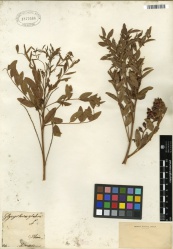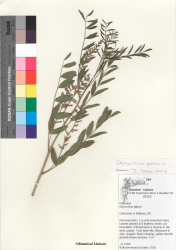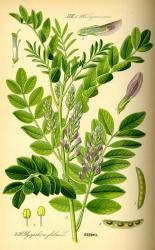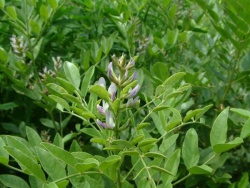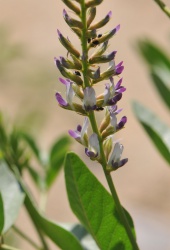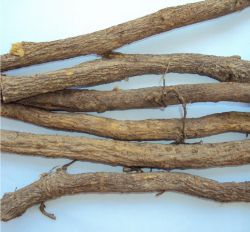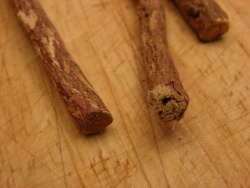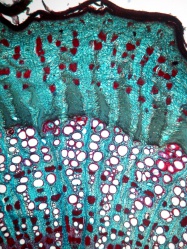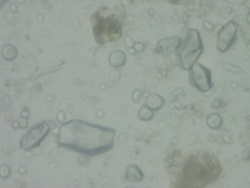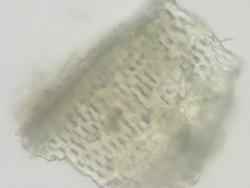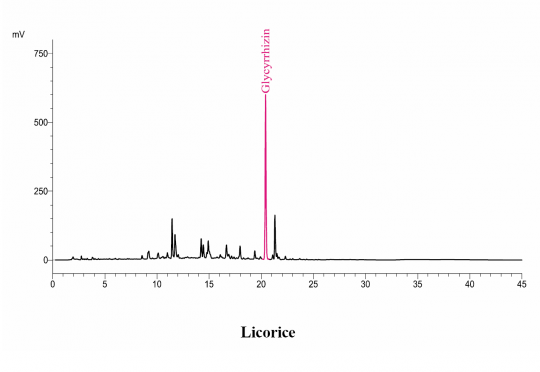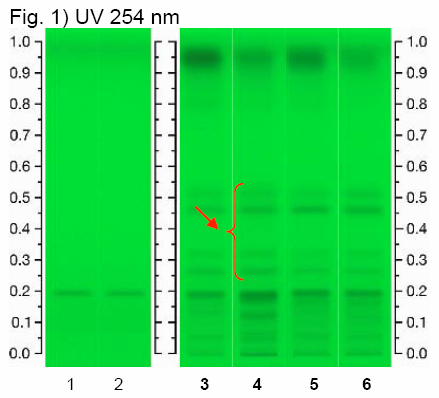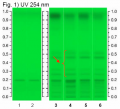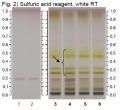Glycyrrhiza glabra (root)
| Line 27: | Line 27: | ||
{| border=1 | {| border=1 | ||
| {{Macroscopy| source=Natural Remedies Pvt Ltd | | {{Macroscopy| source=Natural Remedies Pvt Ltd | ||
| + | | companyURL=http://www.naturalremedy.com/ | ||
| + | | companyimage=Natural Remedies Logo.png | ||
| description='''Color:''' Unpeeled – yellowish or purplish brown to dark brown externally and yellowish internally. Peeled – pale yellow.}} | | description='''Color:''' Unpeeled – yellowish or purplish brown to dark brown externally and yellowish internally. Peeled – pale yellow.}} | ||
| Line 42: | Line 44: | ||
{{Macroscopy| source=Natural Remedies Pvt Ltd | {{Macroscopy| source=Natural Remedies Pvt Ltd | ||
| + | | companyURL=http://www.naturalremedy.com/ | ||
| + | | companyimage=Natural Remedies Logo.png | ||
| description="...Root nearly cylindrical up to 2 cm in diameter, externally wrinkled with patches of cork. Fracture, coarsely fibrous in bark and splintery in wood."}} | | description="...Root nearly cylindrical up to 2 cm in diameter, externally wrinkled with patches of cork. Fracture, coarsely fibrous in bark and splintery in wood."}} | ||
| Line 73: | Line 77: | ||
=Microscopic Characteristics= | =Microscopic Characteristics= | ||
{| border=1 | {| border=1 | ||
| − | | {{ | + | | {{Macroscopy| source=WHO monographs on selected medicinal plants, Vol.1, World Health Organization, Geneva, 1999 |
| description="... In transverse section the cork is thick, brown or purplish brown, formed of several layers of flattened polygonal thin-walled cells; cortex of phelloderm in root somewhat narrow, yellow fibres of parenchyma cells contain isolated prisms of calcium oxalate; phloem, wide, yellow, traversed by numerous wavy parenchymatous medullary rays, 1–8 cells wide and consisting of numerous radial groups of fibres, each surrounded by a crystal sheath of parenchyma cells. Each cell usually contains a prism of calcium oxalate and layers of parenchyma alternating with sieve tissue, the latter occasionally obliterated, appearing as refractive irregular structures; phloem fibres, very long, with very narrow lumen and strongly thickened stratified walls which are cellulosic in the inner part of the phloem and slightly lignified in the outer; xylem, yellow, distinctly radiate; xylem rays, consisting of small pale yellow parenchyma, groups of fibres similar to those of the phloem but more lignified, and surrounded by crystal-sheath, tracheids, and large wide lumen vessels, 80–200 μm in diameter, with thick yellow reticulate walls or with numerous oval bordered pits with slit-shaped openings. Other parenchyma cells contain small round or oval starch granules. Pith, only in rhizome, dark yellow, parenchymatous. Root, with 4-arch primary xylem, no pith and shows 4 broad primary medullary rays, radiating from the centre at right angles to one another. In peeled liquorice, the cork, cortex, and sometimes part of the phloem are absent."}} | | description="... In transverse section the cork is thick, brown or purplish brown, formed of several layers of flattened polygonal thin-walled cells; cortex of phelloderm in root somewhat narrow, yellow fibres of parenchyma cells contain isolated prisms of calcium oxalate; phloem, wide, yellow, traversed by numerous wavy parenchymatous medullary rays, 1–8 cells wide and consisting of numerous radial groups of fibres, each surrounded by a crystal sheath of parenchyma cells. Each cell usually contains a prism of calcium oxalate and layers of parenchyma alternating with sieve tissue, the latter occasionally obliterated, appearing as refractive irregular structures; phloem fibres, very long, with very narrow lumen and strongly thickened stratified walls which are cellulosic in the inner part of the phloem and slightly lignified in the outer; xylem, yellow, distinctly radiate; xylem rays, consisting of small pale yellow parenchyma, groups of fibres similar to those of the phloem but more lignified, and surrounded by crystal-sheath, tracheids, and large wide lumen vessels, 80–200 μm in diameter, with thick yellow reticulate walls or with numerous oval bordered pits with slit-shaped openings. Other parenchyma cells contain small round or oval starch granules. Pith, only in rhizome, dark yellow, parenchymatous. Root, with 4-arch primary xylem, no pith and shows 4 broad primary medullary rays, radiating from the centre at right angles to one another. In peeled liquorice, the cork, cortex, and sometimes part of the phloem are absent."}} | ||
{{Microscopy | source=Natural Remedies Pvt Ltd | {{Microscopy | source=Natural Remedies Pvt Ltd | ||
| + | | companyURL=http://www.naturalremedy.com/ | ||
| + | | companyimage=Natural Remedies Logo.png | ||
| description="Transverse section of stolon more or less rounded. Phellem severeal layered with tabular cells; outer layers filled with reddish brown contents, inner colourless. Phellogen indistinct; phelloderm three to five layered, collenchymatous; some of the cells contain calcium oxalate and minute starch grains. Secondary phloem with numerous concentrically arranged bundles of phloem fibres and surrounded by a parenchymatous sheath containing prisms of calcium oxalate. Medullary rays distinct, bi-to multiseriate, parenchymatous, in continuation with those of xylem. The rays are narrower in xylem and wider in phloem region. Xylem consists of vessels, fibres and lignified wood parenchyma. The unpeeled drug shows the presence of polyhedral tubular brownish cork cells. In case of stolons, the pith is present and is parenchymatous. The root is characterized by the presence of tetrarch xylem and absence of pith. | | description="Transverse section of stolon more or less rounded. Phellem severeal layered with tabular cells; outer layers filled with reddish brown contents, inner colourless. Phellogen indistinct; phelloderm three to five layered, collenchymatous; some of the cells contain calcium oxalate and minute starch grains. Secondary phloem with numerous concentrically arranged bundles of phloem fibres and surrounded by a parenchymatous sheath containing prisms of calcium oxalate. Medullary rays distinct, bi-to multiseriate, parenchymatous, in continuation with those of xylem. The rays are narrower in xylem and wider in phloem region. Xylem consists of vessels, fibres and lignified wood parenchyma. The unpeeled drug shows the presence of polyhedral tubular brownish cork cells. In case of stolons, the pith is present and is parenchymatous. The root is characterized by the presence of tetrarch xylem and absence of pith. | ||
Revision as of 14:22, 30 April 2014
Contents |
Nomenclature
Glycyrrhiza glabra L. Fabaceae
Standardized common name (English): licorice
Ayurvedic name(s): yashtimadhu
Pinyin name(s): guang guo gan cao; gan cao (root & rhizome)
Botanical Voucher Specimen
 |
|
|
|
|
Organoleptic Characteristics
|
Macroscopic Characteristics
|
Microscopic Characteristics
|
High Performance Liquid Chromatographic Identification
|
Licorice (root) (Glycyrrhiza glabra) Sample Preparations: Extract 1.0 g of coarsely powdered Glycyrrhiza root in 50 mL of water by boiling for about 5 minutes, and filter. Repeat for 4-5 times or until the extract is colorless. Combine the extracts, concentrate to about 100 mL, and cool to room temperature. Before injection, filter through a membrane filter of 0.45-um or finer pore size, discarding the first 5 mL of the filtrate. Column: C18, 25-cm x 4.6 mm, 5-um Mobile Phase: 0.14 g of anhydrous potassium dihydrogen phosphate in 900 mL of water, add 0.5 mL phosphoric acid, mix, complete to volume with water, and mix (Solution A); and acetonitrile (Solution B) Elution: Gradient program, see Table below Flow rate: 1.5 mL/min Detection: UV, 254 nm Injection volume: 20 uL Source: Natural Remedies Pvt Ltd [18] Table: Gradient program
|
High Performance Thin Layer Chromatographic Identification
|
Licorice (root) (Glycyrrhiza glabra) Lane Assignments Lanes, from left to right (Track, Volume, Sample):
Other Notes Reference Sample Preparations: Mix 0.5 g of powdered sample with 10 mL of ethanol and water (7:3, v/v), sonicate for 10 minutes, centrifuge or filter the solution, and use the supernatant / filtrate. Stationary Phase: HPTLC, Silica gel 60 F254 Mobile Phase: Ethyl acetate, acetic acid, formic acid, water (15:1:1:2) Development: Saturate chamber for 20 minutes; developing distance 70 mm from lower edge of the plate; relative humidity 33%, temperature 25°. Derivatization reagent: Methanol sulfuric acid reagent- 180 mL of ice-cooled methanol are mixed with 20 mL of sulfuric acid. Detection: a. Examine under UV light at 254 nm b. Dip (time 0, speed 5) in Derivatization reagent, heat at 100°C for 10 min, leave to cool, and examine under visible light. Procedure: Reference Standard Solutions, Stationary Phase, Mobile Phase, Development, Derivatization reagent, and Detection, as described above. Test Sample Preparation: Prepare test sample as described under Reference Sample Preparations and apply 2 uL. Identification: Compare Test Sample Preparation chromatogram with chromatograms of Reference Sample Preparations. The Test Sample Preparation chromatogram is similar to that of the Reference Sample Preparations chromatograms. Additional weak zones may be present. Under UV light, the Test Sample Preparation chromatogram exhibits a quenching zone in the lower-third section of the chromatogram corresponding to the zone due to ammonium glycyrrhizate in the Reference Standard Solution chromatogram. Above it there are four quenching zones corresponding to those marked with red arrows in the Reference Sample Preparations chromatograms. After derivatization and under visible light, the Test Sample Preparation chromatogram exhibits a brown zone in the lower-third section of the chromatogram corresponding to the zone due to ammonium glycyrrhizate in the Reference Standard Solution chromatogram. Above it there are four yellow zones corresponding to those marked with black arrows in the Reference Sample Preparations chromatograms. Note: Images presented in this entry are examples and are not intended to be used as a bases for setting specifications for quality control purposes. Source: HPTLC Association [19] |
Supplementary Information
Sources
- ↑ Tropicos.org. Missouri Botanical Garden. 27 Feb 2014 <http://www.tropicos.org/Image/100253567>
- ↑ Trish Flaster, MSc, Botanical Liaisons, LLC http://www.BotanicalLiaisons.com
- ↑ Natural Remedies Pvt Ltd http://www.naturalremedy.com/
- ↑ American Herbal Products Association. March 2013. Organoleptic Analysis of Herbal Ingredients. AHPA: Silver Spring, MD http://www.ahpa.org/
- ↑ WHO monographs on selected medicinal plants, Vol.1, World Health Organization, Geneva, 1999
- ↑ Natural Remedies Pvt Ltd http://www.naturalremedy.com/
- ↑ Flora von Deutschland, Österreich und der Schweiz- Otto Wilhelm Thomé (1885)
- ↑ Encyclopedia of Life http://eol.org/data_objects/2447928
- ↑ Encyclopedia of Life http://eol.org/data_objects/24932881
- ↑ Natural Remedies Pvt Ltd http://www.naturalremedy.com/
- ↑ Encyclopedia of Life http://eol.org/data_objects/19163752
- ↑ WHO monographs on selected medicinal plants, Vol.1, World Health Organization, Geneva, 1999
- ↑ Natural Remedies Pvt Ltd http://www.naturalremedy.com/
- ↑ Hare, Caspari, Rusby. National Standard Dispensatory (1905)
- ↑ Natural Remedies Pvt Ltd http://www.naturalremedy.com/
- ↑ Natural Remedies Pvt Ltd http://www.naturalremedy.com/
- ↑ Natural Remedies Pvt Ltd http://www.naturalremedy.com/
- ↑ Natural Remedies Pvt Ltd http://www.naturalremedy.com/
- ↑ HPTLC Association http://www.hptlc-association.org/
- Botanical
- Fabaceae
- Macroscopy
- Natural Remedies Pvt Ltd
- American Herbal Products Association. March 2013. Organoleptic Analysis of Herbal Ingredients. AHPA: Silver Spring, MD
- WHO monographs on selected medicinal plants, Vol.1, World Health Organization, Geneva, 1999
- Microscopy
- Hare, Caspari, Rusby. National Standard Dispensatory (1905)
- HPTLC
- HPTLC Association
